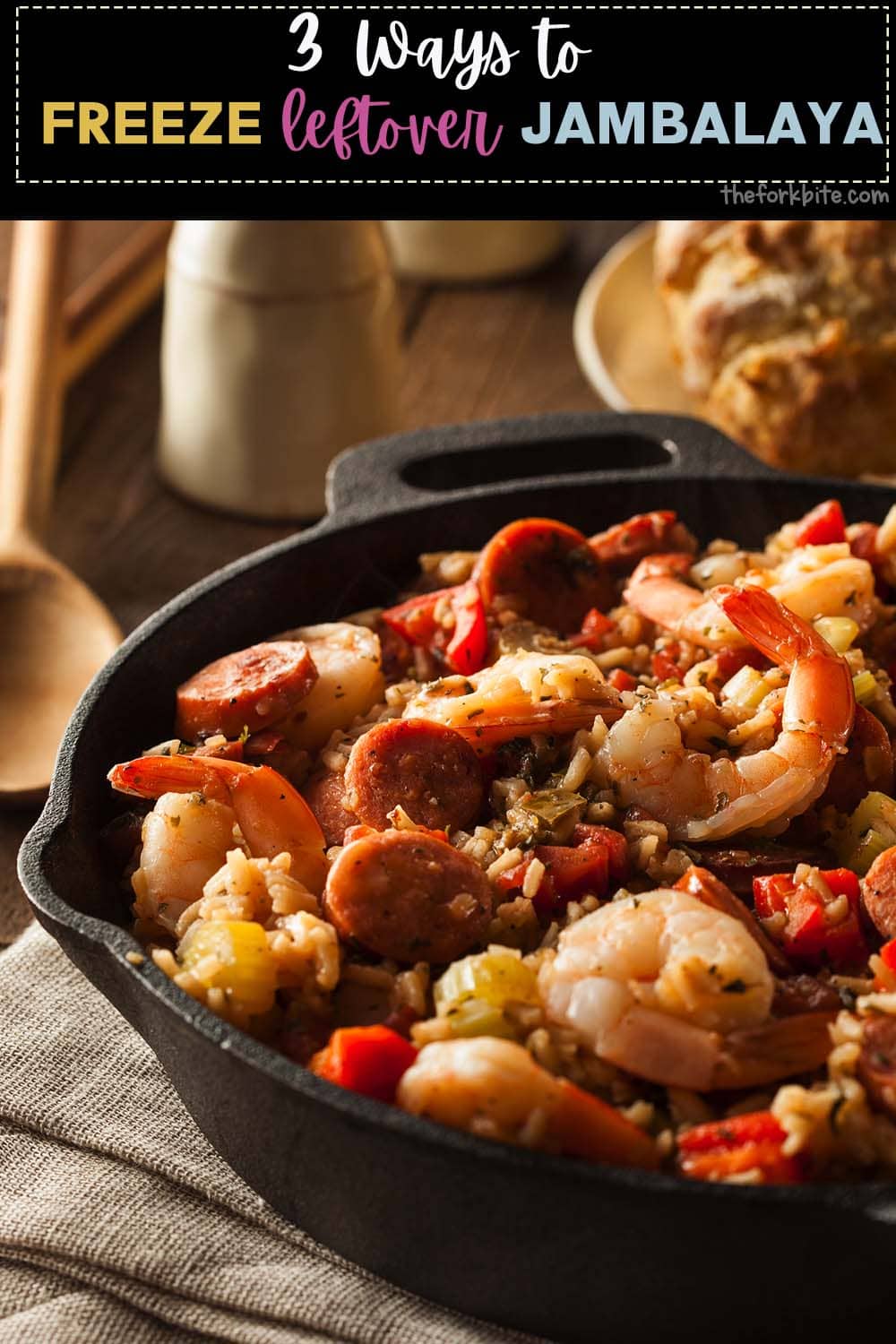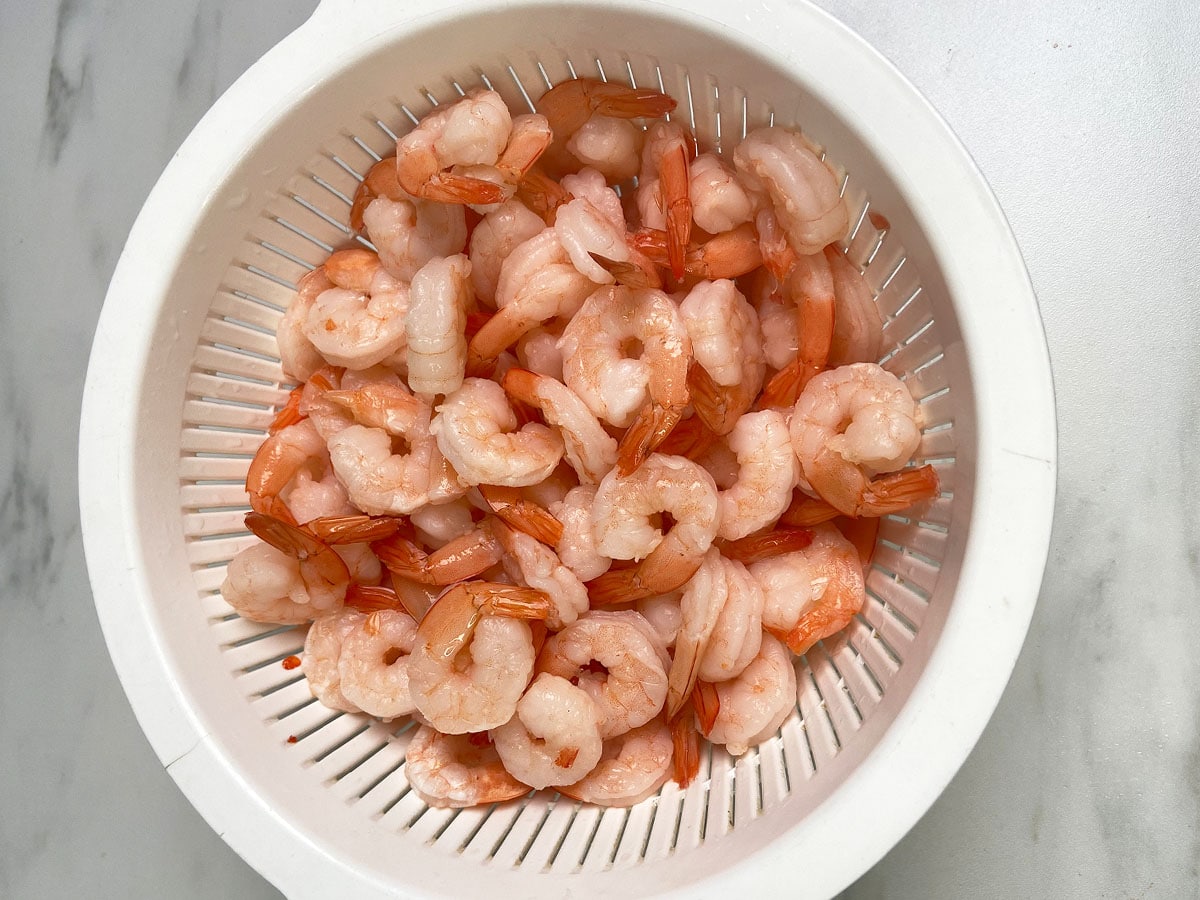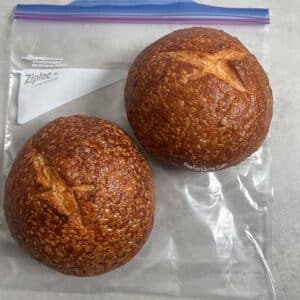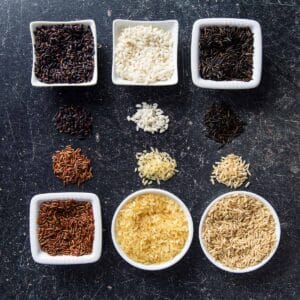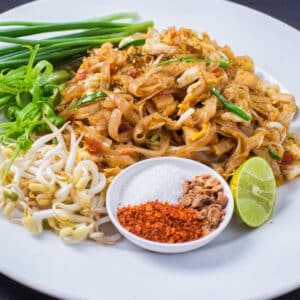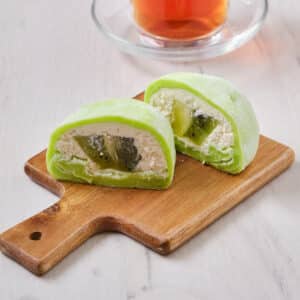Can you freeze Jambalaya? Yes, Jambalaya freezes well. Storing it correctly in an airtight container will help prevent the rice from becoming mushy and protect the dish from freezer burn.
Like most food dishes, reheated, frozen Jambalaya is quite safe to eat if you observe the right practices regarding food hygiene and safety. However, it won't taste quite as good as it did when you cooked it the first time around.
When it comes to one-pot cooking, you won't find any recipes better than that of Jambalaya. You can cook it on your stovetop, in a Dutch oven, or an Instant Pot.
Then, after serving, if you have any leftovers, you'll want to think about storing them. Binning them would be a sin.
You can leave leftovers in the fridge for up to four days - more about that later - or you can store them for longer in your freezer. Again, more about that later.
Let's start by finding out a little bit more about this celebrated southern rice dish.
The origins of Jambalaya
Like many one-pot dishes, people have developed their own takes on the original. Jambalaya started with two distinct variants in the first place - one being Cajun, the other Creole.
Jambalaya, both versions, first appeared in the early 1700s in and around New Orleans in Louisiana, and both are centered around the so-called "Holy Trinity," a mixture of bell peppers, celery, and onion.
Cajun Jambalaya is a brown-colored concoction, while the Creole version has a distinctive red color due to the tomato element. Meat-wise, it was, and still is, a smoked sausage called Andouille or chicken or pork that was used.
Born from Spanish and French Influences
The Creole version of Jambalaya appeared during a 38-year-period when Louisiana was under Spanish control. The Spaniards were trying to make their beloved paella.
The problem was that they couldn't get their hands on any saffron, and they instead used tomatoes which were in plentiful local supply. Hence the Creole, red version of Jambalaya, came into being.
The other big influence in Louisiana in the 18th century was the French. When they took back over from the Spaniards, they introduced some exotic spices from the Caribbean, which intermingled into the local cuisine.
But the further away from New Orleans, the more difficult it was to get hold of tomatoes.
Instead, they browned the meat, which could be a combination of things like an alligator, boar, crawfish, duck, oysters, shrimp, and turtle in rural bayous. The Cajun brown version of Jambalaya was born.
Can you freeze Jambalaya?
At the beginning of this article, I mentioned reheating frozen Jambalaya.
But to get the best results both in terms of flavor and texture, it's essential to store it in the right way.
So read on, and I'll tell you how.
Food for thought before freezing Jambalaya
When I make a new batch of Jambalaya, it usually goes well over the top to freeze it for future use.
It's not the quickest of dishes to prepare and cook, so if you are a busy mom like me, having something tasty in the freezer that you can defrost and reheat when you need it can be a real lifesaver.
But if you decide to make some for the freezer or freeze leftovers, there's a couple of things you need to think about first.
- If you're not careful, rice, when it's frozen, can get quite mushy.
- The other thing to think about is that shrimp can become chewy.
As we progress, I'll go into these two points in a little more detail and discuss with you ways of getting around these problems.
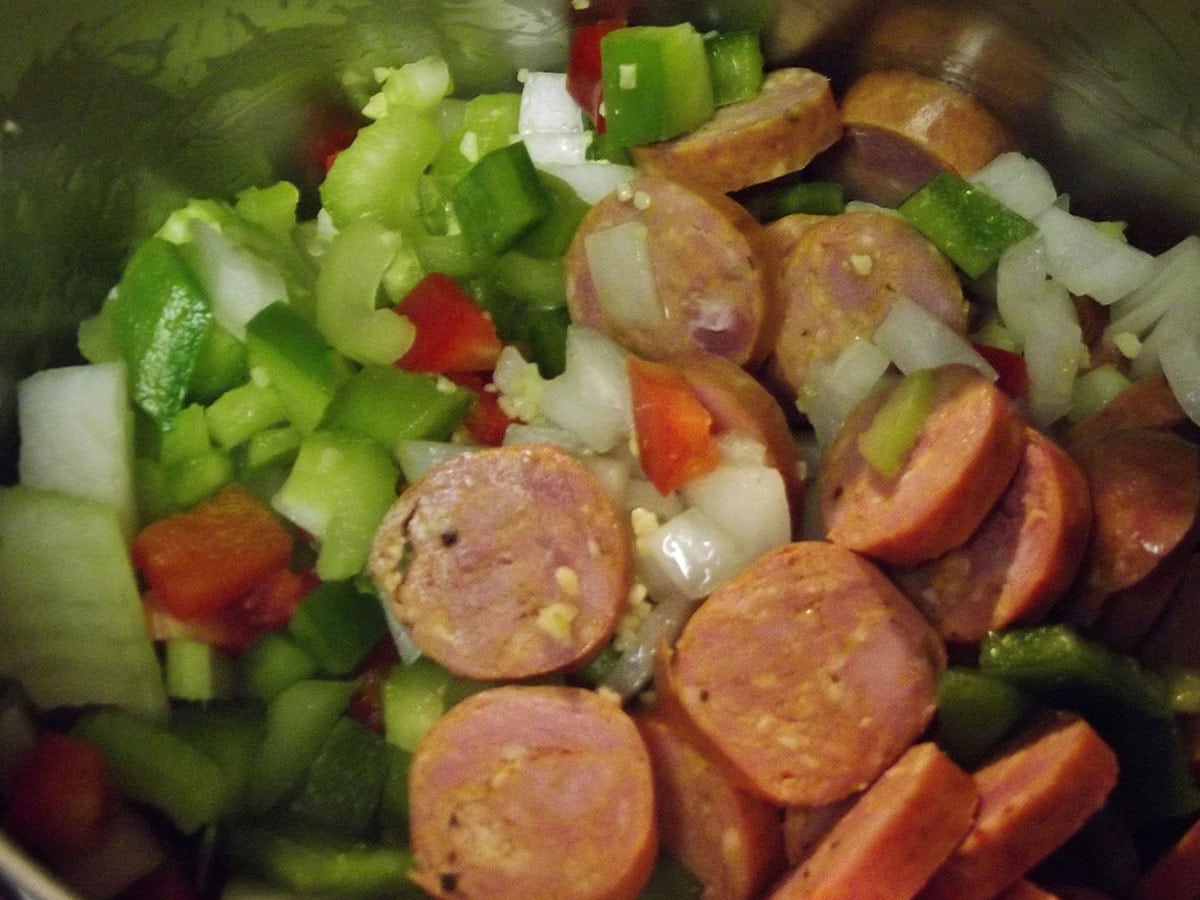
How to avoid chewy reheated frozen shrimp
If you're one of the many people who loves putting shrimp in their Jambalaya, and you're cooking it expressly for the freezer, I would recommend leaving the shrimp out.
If you cook them in the Jambalaya and freeze them, it's pretty nigh on impossible to avoid them being chewy when you come to reheat and eat them.
The best thing to do is not to freeze them in the first place.
It doesn't mean you have to go without your beloved shrimp when it comes to reheating.
You've got two options.
- You can add fresh shrimp and reheat them with the rest of the Jambalaya.
- You can save them separately. Then add the shrimp back up and let them warm up from the rest of the sauce. Or just add them on top of the dish when you plate up.
Avoiding stodgy rice and chewy shrimp
In the same vein that there are two ways of avoiding chewy shrimp, you also have a couple of options when it comes to preventing your jambalaya rice from becoming too stodgy.
Option 1 Add the rice later.
If you leave the rice out when you make your Jambalaya, you can always add it later when it comes to reheating.
- You'll need to defrost and get the once frozen Jambalaya up to a boiling point, then add the rice.
- Bring it back to a boil and allow it to simmer for 20 to 30 minutes, during which time the rice will cook and, in the process, absorb all of those beautiful flavors.
Option 2 Undercook the rice.
The second option allows you to cook the rice when you first prepare your Jambalaya but only do so during the last five minutes of cooking.
That way, the rice will be slightly undercooked when you freeze it. When you come to defrost and reheat, the rice will become fully cooked in the process.
So there you have it, two ways of avoiding the pitfalls of chewy shrimp and stodgy rice.
Whichever options you decide to take, you'll be able to keep your Jambalaya in the freezer for up to three months.
I have some more thoughts on ways of preventing stodgy rice.
How to freeze Jambalaya leftovers
If you didn't think it through and you're left with fully cooked Jambalaya leftovers, rice, shrimp, and all, it's not all doom and disaster.
Suppose you're okay with chewy shrimp, no problem.
If you're not, you're going to have to remove and replace them with fresh products later when reheating. But you can still minimize the damage to the rice.
1 Make use of your vacuum sealer
If you've got a Foodsaver vacuum sealer, now's the time to use it. By evacuating the air from the bag you store your Jambalaya in, you can help to stop the rice from getting too mushy as it freezes.
Here's how to do it
- Prep the vacuum sealer bag.
- Prep and arrange rice you want to vacuum seal. Don't overfill the bag.
- Fill the bag properly and ensure to leave some room between the vacuum-sealed edge and your food. Leave anywhere between three and five inches at the top of the bag.
- Lay the vacuum sealing bag flat on your counter. Start the vacuum sealing process.
- Store your freshly vacuum-sealed food in the freezer.
2 Double bagging
If you don't have a vacuum sealer, you can resort to using a Ziplock freezer bag, but before you seal it, you need to get as much air out as possible.
Then, put it inside another bag and seal it to help protect against freezer burn.
However, because you've got rice in Jambalaya, it's best not to leave it in the freezer for too long.
I suggest no longer than one month; otherwise, the rice will stand more chance of becoming too stodgy.
Here's how to do it
- Prep and arrange the Jambalaya rice in a freezer bag to lay it nicely.
- Make sure to work the bag to get out as much air as possible before freezing.
- Seal or zip the freezer bag, then put it again in another bag for double bagging.
- Or instead, you can wrap the Ziploc bag with aluminum foil, this technique can actually work better than using another bag.
- Store your newly-bagged food in the freezer.
Defrosting overnight in your refrigerator
Defrosting your Jambalaya properly before reheating is essential. The way I would recommend you do it is by removing from the freezer and leaving it in your fridge overnight.
This will allow the temperature to rise slowly without having to expose the dish to room temperature. It will help to prevent the growth of harmful bacteria.
If you froze your Jambalaya in vacuum-sealed bags, you could drop the entire bag into a pan of boiling water until it is thoroughly thawed when it comes to defrosting.
Three ways of reheating frozen Jambalaya
There are three ways you can go about reheating your frozen Jambalaya.
Each method has its pros and cons, so let's have a look at each one in turn.
Method 1 Using your microwave
Where would we be without our microwaves? They are heaven-sent when it comes to reheating food of all kinds, including Jambalaya. Again, forethought comes in handy.
If you know you will be freezing Jambalaya and defrosting in the microwave, it makes sense to store it in microwave-safe containers. It will save you washing up later on.
Follow these steps:
- Remove the Jambalaya from the freezer and place it in your fridge to defrost overnight.
- If you didn't store it in a microwave-safe container, you now need to transfer it into one and cover it with a damp towel or a piece of paper kitchen paper.
- Microwaving a small batch will take no longer than about 30 seconds. Anything bigger will require longer. Give the Jambalaya a stir halfway through the warming process to ensure it heats through evenly.
- Allow it to stand for 30 seconds before serving and eating.
Things to watch out for:
- Don't forget that reheating frozen shrimp is likely to make them chewy.
- If you think it's going to be a little dry after microwaving, add in a little boiling water and stir before you start.
- Frozen Jambalaya should only be defrosted and reheated once and once only.
Microwave Pros
- Quick and convenient.
- Less washing up if you freeze in a microwave-safe container.
- No hanging about waiting for your oven to warm up to temperature.
Microwave Cons
If over microwaved, Jambalaya can become dry, hard, and crunchy.
Method 2 Reheating in the oven
In pre-microwave days, reheating food in the oven was the way to go.
For those who prefer this method, here are the steps to follow:
- Preheat your oven to a temperature of 300°F
- Before putting it into the oven, transfer the Jambalaya into an oven-safe dish.
- To prevent the Jambalaya from drying out, drizzle one tablespoon of broth or water across the surface. Cover with aluminum foil.
- Place into the oven and allow to warm through for 25 to 30 minutes, longer if you're reheating a large batch.
- Check to ensure it is reheated evenly and serves.
Pros of the Oven Method
- Oven heating warms food through evenly.
Cons of the Oven Method
- Long waiting time for the oven to warm up to temperature.
Method 3 reheating on the stovetop
This method of reheating worked well for fresh leftover and defrosted frozen Jambalaya.
If you're going down the route of adding fresh shrimp and uncooked rice, this is undoubtedly the best way to go.
Here's how:
- Transfer the Jambalaya into a suitably sized frying pan and heat on a medium-low setting.
- As the dish warmed through, add a tablespoon of broth or water to prevent it from drying out.
- Allow it to warm through thoroughly. It's best not to allow it to boil as this can detract from the flavor.
- Serve and enjoy
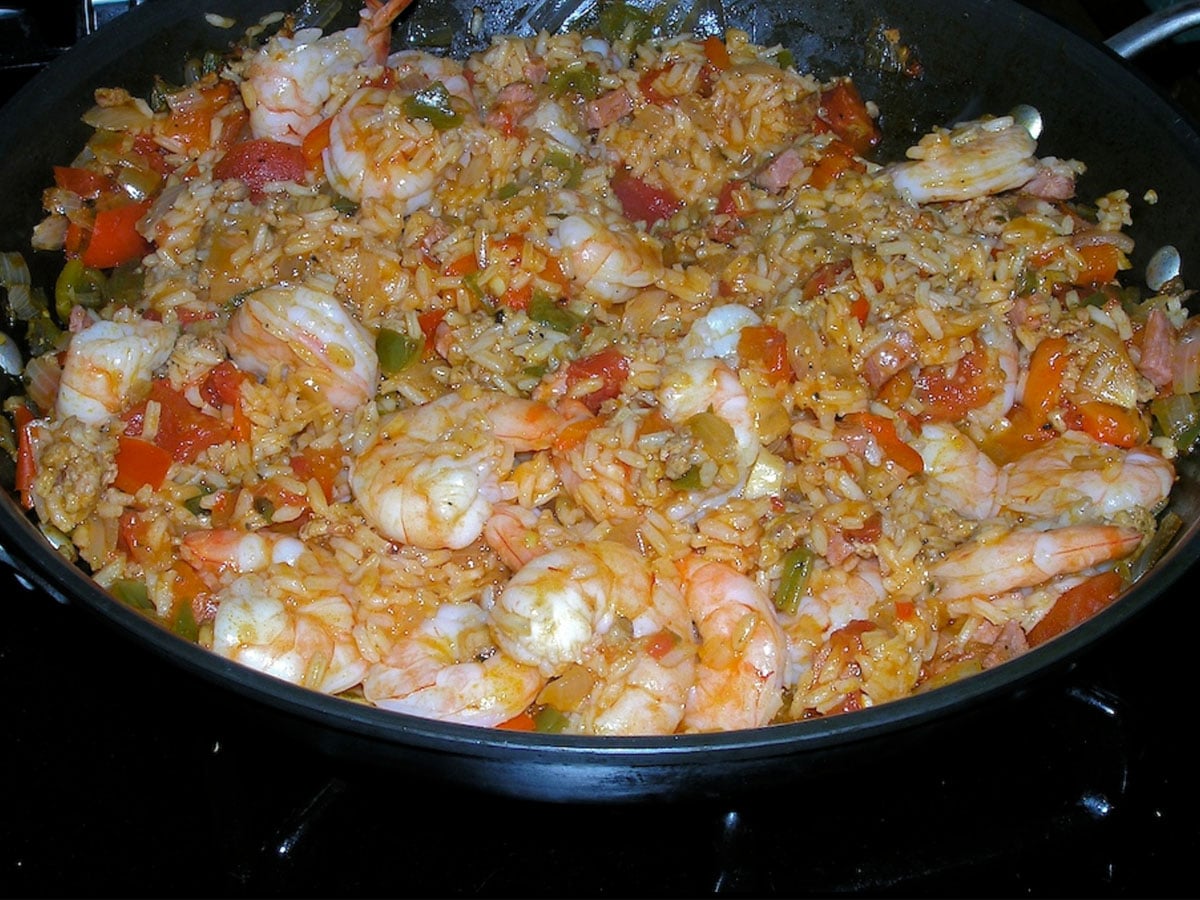
The Pros of reheating on the stovetop
The best method to use when adding fresh shrimp and uncooked rice is to boil and simmer for a few minutes.
The Cons of reheating on the stovetop
- It takes longer than using the microwave.
- If you don't keep your eyes open, the Jambalaya can stick to the bottom of the pan and burn.
How long can you keep Jambalaya in the fridge?
I already mentioned at the outset that if you store it correctly, Jambalaya will be okay for up to four days in your fridge.
How long you refrigerate for should depend on the ingredients used and their relevant shelf lives - seafood being the most tricky one.
Food safety
Whichever one of the three methods you decide to use when it comes to reheating your frozen Jambalaya, one crucial thing related to all three options is to ensure that the dish is reheated to a safe minimum internal temperature. You can use a food thermometer to check this out.
According to the Foodsafety.gov website, reheated foods should reach an internal temperature of the hundred and 165°F.
Avoiding stodgy rice when cooking fresh Jambalaya
Cooking rice well and avoiding getting it too stodgy is an art. But there is a reliable way of doing it which I would like to share with you.
Ordinarily, the basic rule of thumb is to use water to rice in a 2-to-1 ratio. In other words, double the volume of water to the volume of rice.
The thing is that with Jambalaya, you're not looking to get perfect dry fluffy rice; you actually want it to be nice and moist.
The art is in ensuring the rice is cooked properly without it becoming too wet and stodgy.
We will still maintain that 2-to-1 ratio in terms of liquid and rice, but we will also make the liquid in the rice work for us.
This is how:
- Take a can of peeled tomatoes, and drain the juice off into a separate dish.
- Take each tomato in your hand, and squeeze the juice into the dish containing the can's liquid.
- With the tomato flesh in one dish and the juice in another, you now need to ensure that the volume of liquid you have is double that of the rice.
- To make up the right quantity of liquid, you can add chicken stock until you get the required amount.
Both the tomato flesh and the juice are added to the other ingredients.
The benefits of using canned whole tomatoes include:
- Canned whole tomatoes are better quality-wise than their crushed or puréed counterparts.
- Canned tomatoes do not contain firming agents, which stop the tomatoes from being nicely absorbed into the Jambalaya.
- It's much easier to sort the flesh from the juice with canned tomatoes than any other type.
Another little tip:
Now is a good time to add the salt into the tomato liquid, as this will distribute it nicely and evenly when you add it to the other ingredients.
Jambalaya - Freeze Reheat and Enjoy at its Best
There you have it - how best to freeze and reheat Jambalaya and avoid chewy shrimp and soggy rice in the process.
Related questions
Although both are delicious rice dishes, Jambalaya is packed with more flavor and spice. The main spice in paella is saffron which is much milder in flavor.
Jambalaya could be described as a sort of paella, but with much more attitude. Paella celebrates Mediterranean cuisine, whereas Jambalaya is unashamedly Cajun and Creole.
Both have Cajun/Creole origins, but Jambalaya is a rice dish, whereas gumbo is more of a stew.
No, it is not safe to reheat Jambalaya more than once, and the same goes for any rice dish, for if you do, you run the risk of allowing bacteria to develop, which could cause food poisoning.
Yes, Jambalaya freezes well. However, storing it correctly in an airtight container will help prevent the rice from becoming mushy and protect the dish from freezer burn
Check this post to find 10 dishes that go well with Jambalaya.
Other interesting recipes:
- How to Reheat General Tso Chicken
- How to Reheat Lasagna Without Drying Out
- How to Reheat Nachos
- How to Reheat Empanadas
Can you Freeze Jambalaya (How-to)
Pin RecipeEquipments:
- Vacuum sealer
- Freezer bag
- Aluminum foil
Ingredients:
- Jambalaya (leftover)
Instructions:
Use a Vacuum Sealer:
- Prep the vacuum sealer bag.
- Prep and arrange rice you want to vacuum seal. Don't overfill the bag.
- Fill the bag properly and ensure to leave some room between the vacuum-sealed edge and your food. Leave anywhere between three and five inches at the top of the bag.
- Lay the vacuum sealing bag flat on your counter. Start the vacuum sealing process.
- Store your freshly vacuum-sealed food in the freezer.
Double Bagging / Wrapping:
- Prep and arrange the Jambalaya rice in a freezer bag to lay it nicely.
- Make sure to work the bag to get out as much air as possible before freezing.
- Seal or zip the freezer bag, then put it again in another bag for double bagging. Or instead, you can wrap the Ziploc bag with aluminum foil, this technique can actually work better than using another bag.
- Store your newly-bagged food in the freezer.
Notes:
- If you’re not careful, rice, when it’s frozen, can get quite mushy.
- The other thing to think about is that shrimp can become chewy.
You’ve got two options to resolve this issue:
- You can take off the shrimp before freezing and just add fresh shrimp when reheating them with the rest of the Jambalaya.
- You can save them separately with a bit of seasoning and just add them on top of the dish when you plate up.
Please note that all nutrition information are just estimates. Values will vary among brands, so we encourage you to calculate these on your own for most accurate results.

